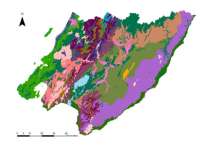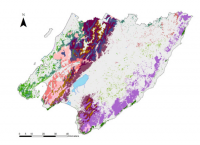You don't know what you've got 'till it's (almost) gone
 Original forest cover Original forest cover |
 Today's remaining forests Today's remaining forests |
A just-published stocktake of forests in the greater Wellington region reveals the extent of historic clearing and shows that much of what's left is vulnerable or in danger of being lost.
Written by Nick Singers, Dr Philippa Crisp and Owen Spearpoint of Greater Wellington Regional Council, Forest Ecosystems of the Wellington Region charts the decline of forest habitat ecosystems which once covered around 782,000 ha in the Wellington region.
Roughly 214,000 ha now remain, about 27% of historic cover.
"This is key information because without a clear picture of the current circumstances facing our forests it would be impossible to target forest types in need of most attention. Without them we will suffer habitat loss and its negative impact on native fauna.
"In short, both from a habitat and carbon sequestration perspective, we need more and more varied forests throughout the region," says Greater Wellington Team Leader, Land, Ecology and Climate Dr Philippa Crisp.
The biggest casualties of clearing have been lowland forests, which were easily felled and have had to compete for space with farming and urban growth.
"Loss of lowland forest is significant because all of these forests would have provided habitat for native fauna such as birds, lizards, bat and invertebrates,"
"Today the breeding habitat of many of the remaining native bird species is restricted to the larger old growth forest areas of the Tararua, Rimutaka and Aorangi Ranges."
Seven of the 21 forest types are rated as critically endangered and are threatened by grazing, weeds, pest animals and fragmentation.
A good example is the totara, matai and ribbonwood forests that were abundant on the Wairarapa Plains and on Te Horo Plain, south of the Otaki River. Today only 3 per cent of this forest type remains, with a small remnant to be found in the Soldiers Memorial Park in Greytown.
"Some forest types are now less than 2 per cent percent of their original size. It they are to thrive again we'd urge landowners to actively manage what remains and, hopefully, plant more.
"On the positive side of the ledger, where programmes are in place to protect and enhance native forests, the results can be impressive. Intensive pest control areas, such as Pukaha, Wainuiomata Mainland Island, Zealandia, and the pest-free islands of Kāpiti, Mana and Matiu/Somes are playing an important role in aiding the recovery of the populations of many of these species.
"The remaining lowland remnants still provide food for many native species."
The report will provide vital information for use in prioritising forest protection through decisions about land use and planting. It will help landowners, planners and conservation agencies with ecological restoration and prioritising funding for maintaining the region's biodiversity.
"This incredibly useful stocktake confirms that 73% of our regions forests have been lost and what remains are vulnerable. Our region needs to tap into the billion trees initiative and rapidly increase our forest cover," says Greater Wellington councillor and chair of the Environment Committee Sue Kedgley.
Landowners with forest remnants on their land are being urged to protect them by identifying forest types on the land, fencing them to keep stock out, controlling plants and animals, retiring land that contains threatened forest types and placing threatened forest types in QEII covenants.
Existing forests can be strengthened by planting around the remnants where possible using eco-sourced plants native to the area.
Get in touch
- Phone:
- 0800 496 734
- Email:
- info@gw.govt.nz
